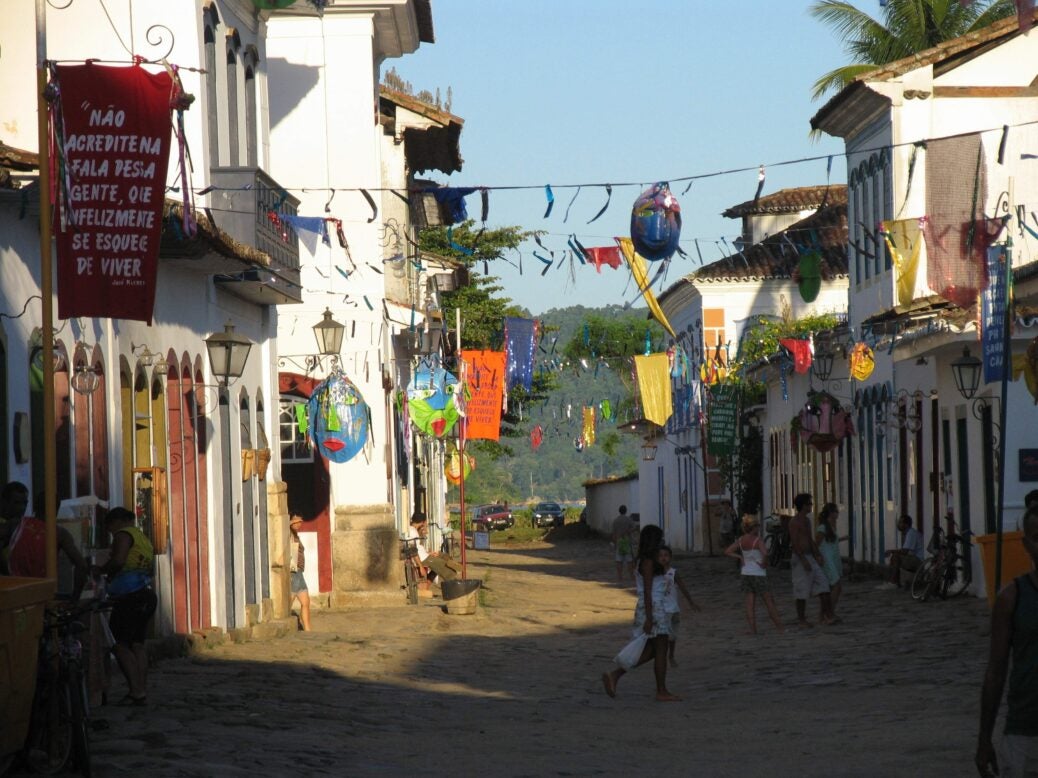
Swim with phosphorescent plankton in Paraty and taste the urban bustle of São Paolo to experience two sides of Brazil’s character, writes Hugh Thompson
With a population of over 20 million, São Paulo is the biggest urban centre in the Americas, and one that defies the imagination. From the top of the Renaissance Hotel, a series of almost identical cities rings the horizon, all interlocking and looking as if they had been CGI’d together to form one vast metropolis for the silver screen.
The film that immediately came to mind was Terry Gilliam’s Brazil. São Paulo has a very similar ‘retro-futurist’ look: fantastic modern architecture existing cheek-by-jowl with decaying favelas and old tenement buildings. Helped by the climate and the Brazilian disposition, so much of life in São Paulo is lived on the street.
We spent a Sunday strolling the fashionable Avenida Paulista, which, like a few other São Paulo highways, is closed to traffic over the weekend, so that the inhabitants can show off their tattoos. At MASP (the São Paulo Museum of Art), each picture stands on an individual perspex plinth in the middle of the room, so you can walk around each one.
The cumulative effect was a museum of the imagination, in which the viewer’s necessarily circuitous tour might present them unexpectedly with a Modigliani, Gauguin or Monet. The drive to the coast slowly revealed the richness of the approaching Atlantic Forest which surrounds the beach resort of Paraty.
Although much of this has been cut down over the centuries since the Portuguese invasion, the remaining areas show a biodiversity which puts even the Amazon to shame. This is a wonderful and fecund rainforest, with bromeliads among the palms and tree ferns. Banana plants give shelter to a riot of shadeloving plants, and there is enough mango, pineapple and açaí to keep the smoothie stalls along the route busy.
Paraty itself is a charming small colonial port town, with cobbled streets and 19th-century buildings. After being briefly the conquistadors’ export town for all the considerable gold from inland Minas Gerais, and then, for many profitable centuries, for coffee, a new railway in 1880 bypassed the town by going straight to Rio. Almost overnight, the port’s population was decimated from 20,000 to 2,000.
It was a ghost town, until the first motorways were built in the 1970s and tourists started to come from the cities for the weekend. Now it is a rare enclave of historical sanctuary in a country which has always rebuilt with ferocity. The area around Paraty is located inside the Environmental Protection Area (APA), and is still surrounded by traditional fishing communities. We wandered the cobbled streets at dusk to enjoy the evening passeio, that fine ritual of Latin countries in which the locals stroll around the square to sample ice creams and confectioneries and pass the time of day.
Although there may be heli-jams in high season when the rich fly in, I was struck by how millionaires’ houses still neighbour those of fishermen. It is as easy to buy a $1,000 embroidered dress as it is some home-made candles from a young boho couple hitching from Argentina to Colombia.

There are also terrific local restaurants – the best of which, Banana Da Terra, uses the titular local plantains to great effect in its fish stews. The Casa Turquesa on the seafront is the place to stay. Elegant airy rooms with huge mosquito nets surround a plunge pool. From the first hit of the strong turquoise caipirinha (they add Curacao to the local cachaca), I knew I was in good hands – in this case, those of Tetê Etrusco and her staff. It’s a long time since I felt so at home in a hotel.
The Casa Turquesa provides Wellington boots for its guests, which may seem unexpected, but is necessary due to one of Paraty’s most unusual features. The Portuguese built the main streets below the high tide mark deliberately, so the sea can come and flush the town clean on a regular basis.
Just up above the town, I walked the old Gold Trail with local guide Harry Cowan, an Anglo-Argentine who has made his base here for many years, and could tell you everything from how palm hearts are extracted to the staggering extent of the local slave trade in 17th-century sugarcane plantations.
Out in the bay and beyond extends an archipelago of wooded islands. To explore these, Bespoke Brazil arranged for us to stay at a wonderful private house available for rent, the Casa Cairuçu. This three-bedroomed house overlooks the bay, with its own private jetty, and kayaks and paddle boards so we could cross over to the small island of Mantenimento opposite, with its resident population of marmosets.
Hammocks lined the terrace decking, and after an afternoon siesta, nothing could quite beat swimming from the jetty into the phosphorescent waters at dusk, as the plankton emitted the phosphorescence that swirled around us.
Nothing had prepared me for the beauty of this stretch of the Atlantic Forest, not even the poems of Elizabeth Bishop, who lived along this coast and described how the clouds continually collapse off the mountaintops like waterfalls in soft slow-motion. In just a week here, you will have penetrated to the very essence of what makes Brazil so special and different.
This piece first appeared in the Spear’s Magazine Travel Guide. To buy a copy, click here.










